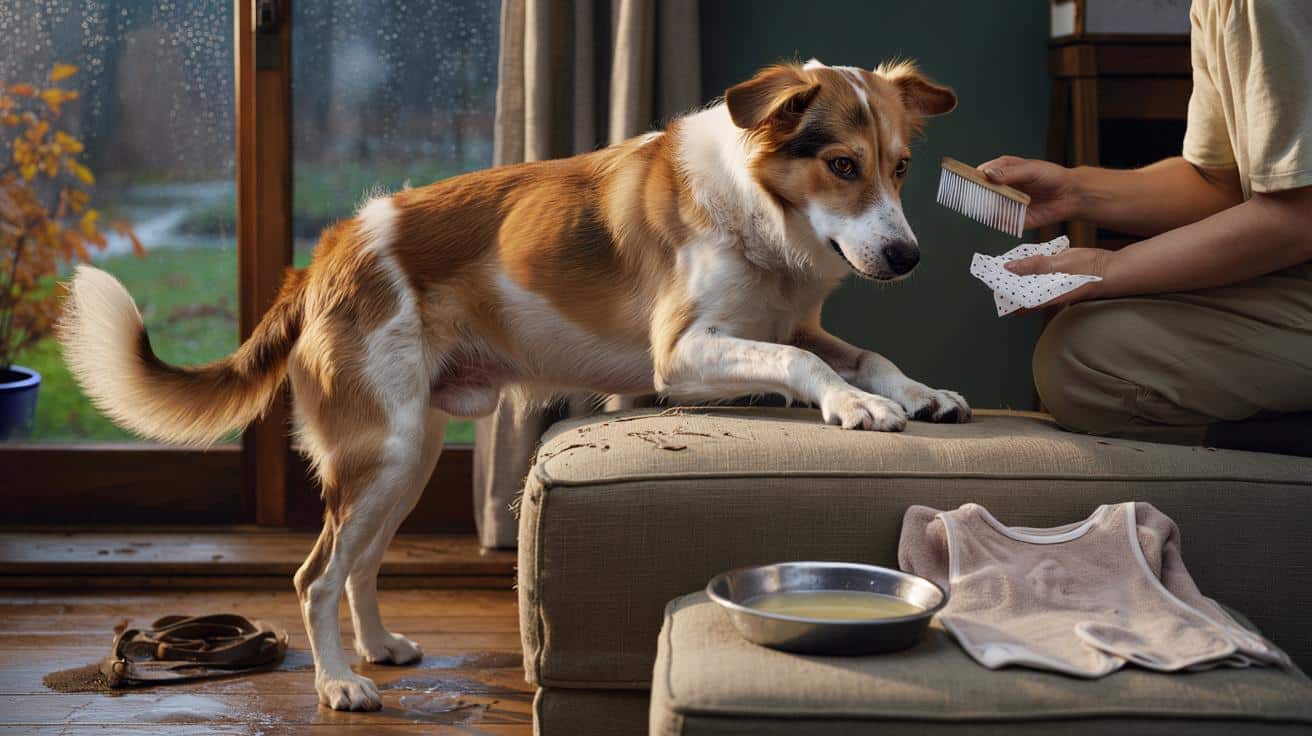Something small shifts in routine, and owners start to notice.
That sudden shimmy along the sofa or determined shoulder slide against the coffee table often looks playful. Sometimes it is. Yet the pace, the places targeted and what follows next can point to itching, soreness or a brewing skin issue. Reading those clues early saves discomfort, money and time.
Why dogs rub against furniture
Dogs spread their scent, dry off, scratch hard-to-reach spots and seek pressure relief. Damp weather magnifies that urge. So does moulting when loose undercoat prickles the skin. A few rubs after a wet walk rarely matter. Repetition and intensity change the picture.
Watch the pattern. A dog that rubs once, sighs and settles likely sought comfort. A dog that circles rooms, presses the same area again and again, then licks obsessively may feel genuine irritation.
When normal becomes worrying
- Compulsive licking or chewing, especially paws and flanks
- Redness, heat, or small bumps under the fur
- Localised hair loss or new bald patches
- Crusts, scabs, or weeping lesions
- Musty or sour odour from the skin or ears
- Restless nights or frequent sleep interruption
- Head shaking, ear tilting, or rubbing the head on carpets
- Scooting the bottom or licking the rear
- Changes in mood, appetite, or playfulness
Persistent rubbing signals itch or pain until proven otherwise. Frequency and fallout matter more than the act itself.
Autumn culprits: parasites, moisture and moulting
Fleas thrive in soft furnishings, even as temperatures drop. One bite can trigger a full-body itch in sensitive dogs. Ticks hitch a ride from leaf litter to the living room. Mites can inflame ears or skin folds. Humidity keeps the skin damp, while the seasonal coat shift can snag, mat and irritate.
Household triggers add to the mix. Detergents, new fabric sprays, fragranced floor cleaners and certain fibres can spark contact reactions. Diet can play a role as well, with food sensitivities showing as chronic itch, ear gunk and repeated paw chewing.
Check the coat and ears after every walk, keep parasite prevention up to date, and dry thoroughly from nose to tail.
Nine clues your furniture can reveal
Where and how your dog rubs often narrows the likely cause. These patterns help you triage at home.
- Base of tail on sofa arms: flea bite hypersensitivity is common at the rump.
- Head and ears on rugs: think ear infection, mites or yeast overgrowth.
- Flanks along doorframes: dry skin or allergens brushing exposed sides.
- Neck under tables: collar chafing, matted hair, or contact irritation from sprays.
- Chest on carpets after rain: trapped moisture under dense fur causing itch.
- Back on skirting boards in a wave: dry coat, moulting undercoat, or dandruff.
- Rear on low furniture (scooting): full or irritated anal glands, worms, or dermatitis.
- Paws on upholstery with licking: environmental allergens or road salt residue.
- Whole-body shimmy with musty odour: yeast flare in skin folds or ears.
Three urgent vet triggers
- Self-trauma: open sores, bleeding, pus, or swelling that spreads within hours.
- Unrelenting itch for more than 48 hours despite basic cleaning and rest.
- Systemic signs: fever, lethargy, shaking, loss of appetite, or sudden pain.
Avoid repeated shampoos, human creams, or random antihistamines. They can mask signs, delay care, or cause harm.
What you can do in the next 24 hours
- Part the fur under bright light. Check ears, armpits, groin, tail base and between toes.
- Run a flea comb from neck to tail. Wipe on white tissue to spot flea dirt.
- Dry the coat thoroughly after walks. Towel first, then use a cool-setting dryer if the coat is dense.
- Wash bedding at 60°C and vacuum skirting boards, under sofas and along favourite routes.
- Wipe paws with lukewarm water. Remove grit, grass seeds and road salt.
- Note any new foods, treats, detergents or sprays used in the last seven days.
- Confirm parasite protection is in date and appropriate for your dog’s weight.
- Use a soft cone or a body suit if chewing creates wounds.
| Likely cause | Signature sign | Practical first step |
|---|---|---|
| Fleas | Itch at tail base, black specks on comb | Apply vet-advised flea control; treat home and bedding |
| Ear infection | Head rubbing, odour, dark discharge | Keep ear dry; book prompt ear exam and cytology |
| Contact reaction | Red belly or armpits after floor cleaning | Rinse skin, switch to fragrance-free products |
| Moulting and dry skin | Dandruff, relief after brushing | Brush daily; add humidity indoors; consider omega‑3s |
| Anal glands | Scooting, licking the rear, fishy odour | Keep area clean; seek gland check if repeated |
| Food sensitivity | Chronic paw chewing, ear gunk, soft stools | Discuss an elimination diet plan with your vet |
Care choices that reduce flare-ups
Groom little and often. Ten minutes of brushing after wet walks frees trapped undercoat and spreads natural oils. Choose a mild, fragrance-free shampoo and limit baths to genuine dirt or medical advice. Keep nails short so scratching does less damage. Aim for steady weight; skin folds often improve when your dog slims down.
Pick fragrance-free laundry powder for dog bedding. Rinse twice. Rotate two beds to allow full drying. Keep living spaces well ventilated to lower humidity. Use monthly parasite prevention suited to your dog’s size, lifestyle and any travel plans.
Behaviour, stress and territory
Rubbing can also soothe stress. New furniture, visitors or building noise may shift scent cues and raise anxiety. Offer predictable routines, calm resting places and scent-swaps for new beds. Provide chew toys and short training sessions to channel energy. If rubbing clusters around doors and window ledges, scent-marking likely plays a role. Neutering, structured walks and enrichment often help.
Extra context for the coming months
Indoor heating dries skin as winter sets in. A bowl of water near radiators, a room humidifier, and fatty acids from marine fish oil can support the skin barrier. Ask your vet before supplements if your dog takes medication or has pancreatitis risk.
Anal gland issues spike when exercise drops and stools soften. Keep fibre steady, plan brisk daily walks, and monitor any scooting. Ear problems persist in dogs with heavy, pendulous ears. Dry ears after rain and check weekly with a torch. Early action prevents deep infections that need longer treatment.
If in doubt, film a 30‑second clip of the rubbing and note time, place and triggers. That record speeds diagnosis.








